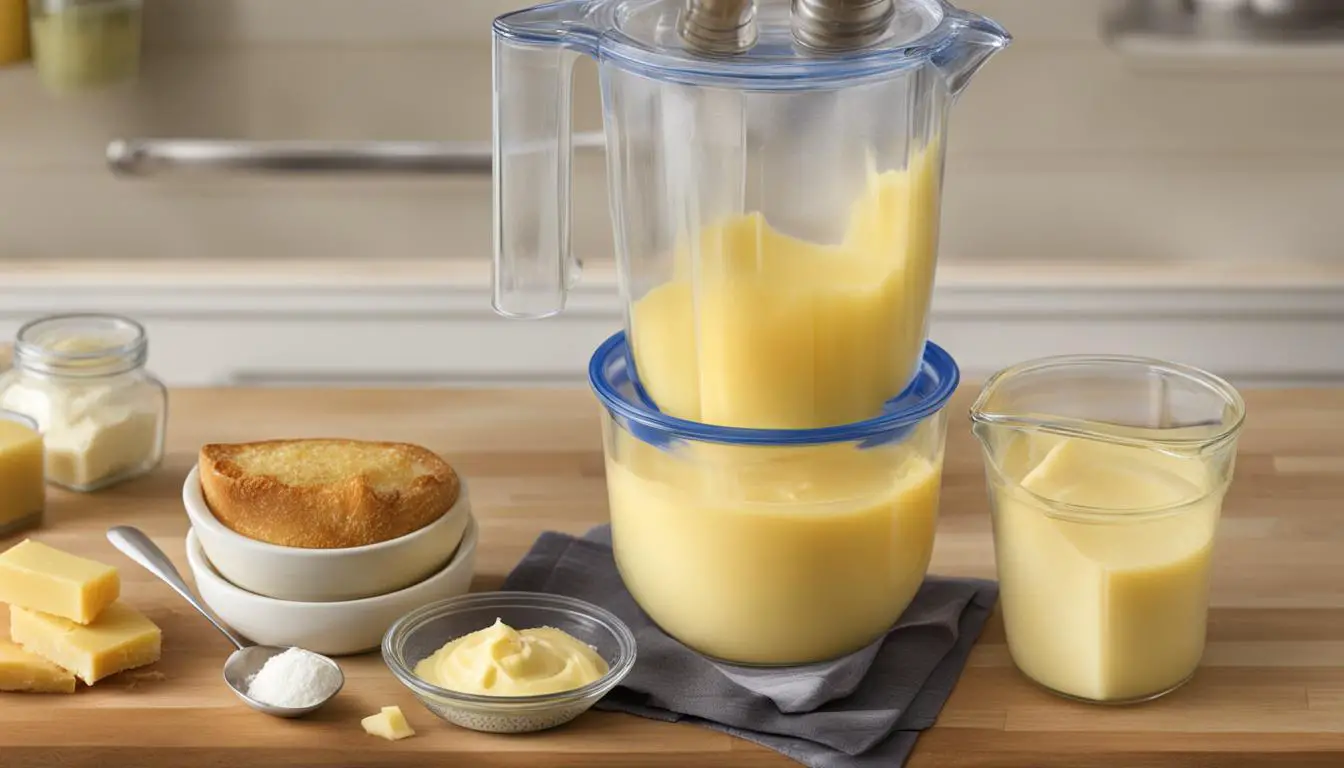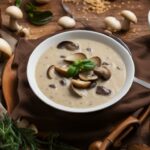Using melted butter in baking recipes can have a significant impact on the final outcome. Melted butter is a versatile ingredient that can be used as a substitute for softened butter in many recipes. It creates a different texture and can affect the rise and density of baked goods. By understanding the effects of melted butter, you can make informed decisions when it comes to your baking recipes.
Contents
- 1 Advantages of Using Melted Butter in Baking
- 2 Differences Between Melted Butter and Softened Butter
- 3 Effects of Melted Butter on Pie Crusts
- 4 Impact of Melted Butter on Cookies and Cakes
- 5 When to Use Melted Butter Instead of Softened Butter
- 6 Techniques for Melting Butter
- 7 Softened Butter vs Melted Butter: Pros and Cons
- 8 Tips for Using Melted Butter in Baking
- 9 Melted Butter for Buttercream and Frosting
- 10 Baking Tips for Using Melted Butter
- 11 Conclusion
- 12 FAQ
- 12.1 Does using melted butter change a recipe that calls for softened butter?
- 12.2 What are the advantages of using melted butter in baking?
- 12.3 What are the differences between melted butter and softened butter?
- 12.4 How does melted butter affect pie crusts?
- 12.5 How does melted butter impact cookies and cakes?
- 12.6 When should I use melted butter instead of softened butter?
- 12.7 What are some techniques for melting butter?
- 12.8 What are the pros and cons of softened butter versus melted butter?
- 12.9 What tips should I follow when using melted butter in baking?
- 12.10 Can I use melted butter for buttercream and frosting?
- 12.11 What baking tips should I keep in mind when using melted butter?
- 12.12 What is the conclusion regarding the effects of melted butter on a recipe?
- 13 Source Links
Key Takeaways:
- Melted butter offers several advantages in baking, such as convenience and contributing to a moist and tender texture.
- There are differences between melted butter and softened butter, with melted butter resulting in a denser and chewier texture in baked goods.
- Melted butter can create a different texture in pie crusts and cookies, offering a tender and shortbread-like crust and denser, lower-profile cookies.
- When using melted butter, it is important to consider the recipe, adjust as needed, and ensure the butter is at the right temperature for optimal results.
- Melted butter may not be suitable for all applications, such as buttercream and frosting, where a specific texture and consistency are desired.
Advantages of Using Melted Butter in Baking

Melted butter can be a game-changer when it comes to baking. This versatile ingredient offers several advantages that can enhance both the flavor and texture of your baked goods. Let’s explore the benefits of incorporating melted butter into your recipes.
Convenience: One of the main advantages of using melted butter is its convenience. Unlike softened butter, which needs time to reach the desired consistency, melted butter is quick and easy to prepare. Simply heat it gently on the stovetop or in the microwave until it transforms into a liquid form. This time-saving process is perfect for when you’re in a rush or want to streamline your baking experience.
Easy Incorporation: Incorporating melted butter into your batter or dough is a breeze. Unlike using softened butter, which often requires a mixer to achieve proper blending, melted butter can be easily mixed in by hand. This low-maintenance approach simplifies your baking process and eliminates the need for additional equipment.
Moist and Tender Texture: Melted butter can contribute to a moist and tender texture in your baked goods. When melted butter is added to the recipe, it coats the flour particles more effectively, resulting in a softer and more delicate final product. Whether you’re baking cookies, cakes, or muffins, using melted butter can help you achieve a delectably moist and tender texture that will impress your taste buds.
With its convenience, easy incorporation, and ability to create a moist and tender texture, melted butter is a valuable ingredient in baking. Whether you’re a novice baker or an experienced pastry chef, adding melted butter to your recipes can elevate your creations to new heights. Experiment with different melted butter recipes and cooking techniques to discover the delightful results that this simple ingredient can bring to your baked treats.
Differences Between Melted Butter and Softened Butter
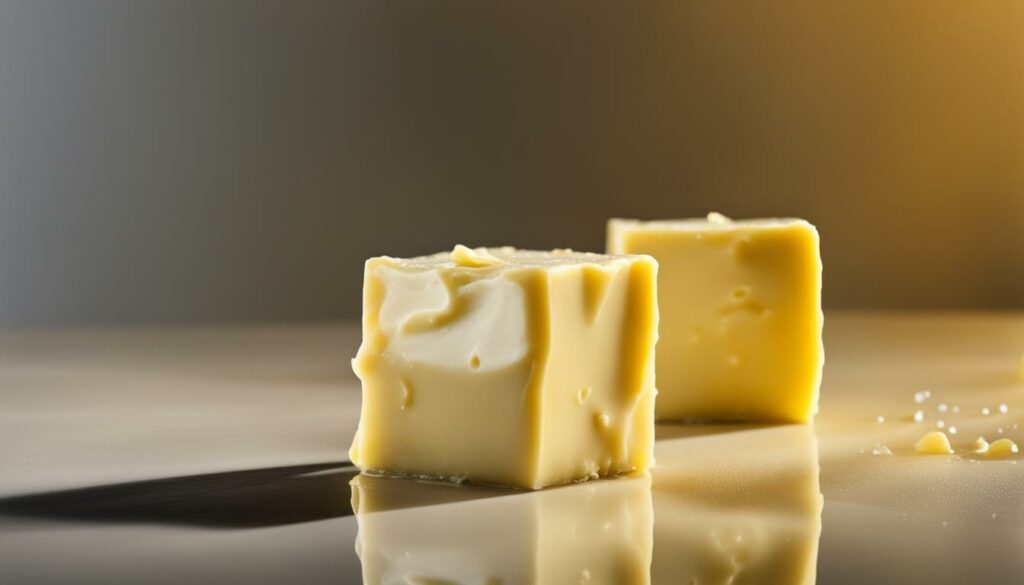
When it comes to butter in baking, both melted butter and softened butter have distinct differences that can impact the final outcome of your recipes. It’s important to understand these differences to determine when to use melted butter in your baking endeavors.
Softened butter, commonly used in baking, is often creamed with sugar to incorporate air into the dough. This creaming process results in a lighter texture when the dough is baked. The air trapped in the butter-sugar mixture creates a fluffy and tender baked good.
On the other hand, melted butter does not incorporate air into the dough. As a result, using melted butter can lead to a denser and chewier texture in baked goods. The absence of air pockets in the dough affects the rise and overall density of the final product.
Understanding these differences allows you to make informed decisions when choosing between melted butter and softened butter in your recipes. Melted butter can be a great option for achieving a different texture in your baked goods, such as a denser and chewier profile. However, for recipes that require a lighter and fluffier texture, softened butter is typically the preferred choice.
To visually illustrate the differences between melted butter and softened butter, refer to the table below:
| Melted Butter | Softened Butter |
|---|---|
| Does not incorporate air | Creamed with sugar to incorporate air |
| Results in a denser, chewier texture | Creates a lighter, fluffier texture |
| Melts easily and quickly | Requires time to reach softened state |
As you can see, melted butter and softened butter have their own unique qualities and effects on your baked goods. By understanding these differences, you can choose the right butter option for your recipes, resulting in the desired texture and taste.
“Understanding the differences between melted butter and softened butter is crucial for achieving the desired texture and outcome in your baking recipes.”
Effects of Melted Butter on Pie Crusts
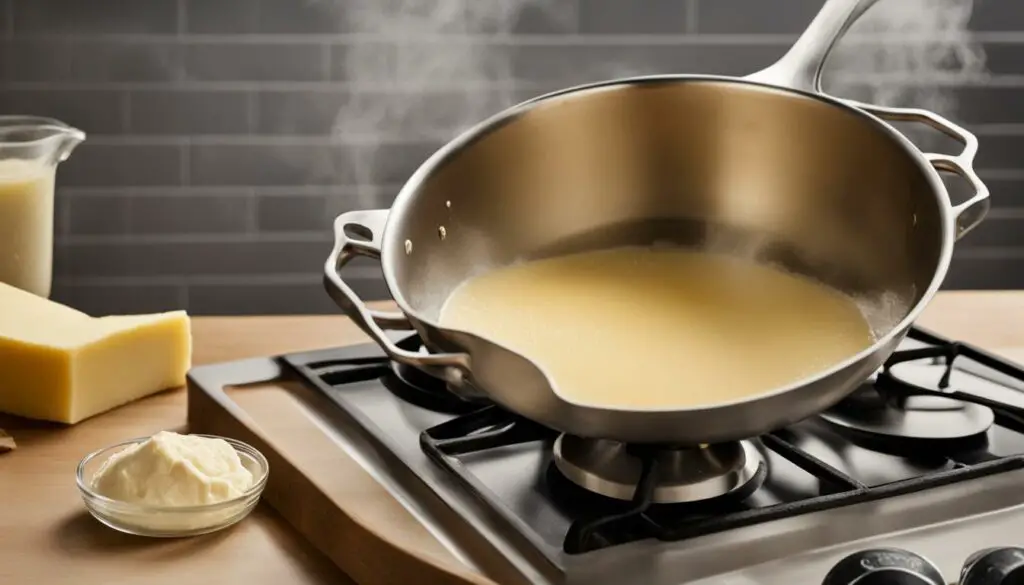
When it comes to pie crusts, the choice between using cold butter and melted butter can significantly impact the texture and taste. Traditional pie crust recipes often call for cold butter, which creates flaky layers due to the steam produced during baking. However, using melted butter offers a different approach, resulting in a more tender and shortbread-like crust.
While melted butter may not achieve the same level of flakiness as cold butter, it provides a time-saving alternative for those who prefer convenience without compromising on taste. The melted butter blends easily with the other ingredients, making it simpler to work with when preparing the pie crust dough.
In a melted butter pie crust, the butter is already in a liquid state, eliminating the need to cut it into small pieces or work it into the dough. This means less effort and time spent on preparation, allowing you to enjoy a homemade pie with minimal fuss.
To make a pie crust with melted butter, start by melting the required amount of butter using your preferred method, such as in the microwave or on the stovetop. Once melted, allow the butter to cool slightly before incorporating it into the flour, salt, and other ingredients for the crust.
When working with melted butter, it’s important to note that the texture of the resulting pie crust will differ from one made with cold butter. While it may not have the same flakiness, the crust will still be deliciously tender and flavorful. Be sure to adjust your technique and expectations accordingly.
If you’re in a hurry or looking for a simpler baking method, using melted butter in your pie crust can be a game-changer. It offers a tasty alternative that saves time without compromising on the overall quality of your homemade pies.
Impact of Melted Butter on Cookies and Cakes

The use of melted butter in cookies and cakes can have a significant impact on their texture and overall outcome. Traditional recipes often call for creaming room-temperature butter with sugar to create fluffy and light cookies and cakes. However, using melted butter in these recipes can result in denser, lower-profile treats that offer a different texture profile.
Melted butter brings its own unique qualities to baked goods. It adds moisture and richness, giving cookies and cakes a desirable chewiness. While it may not provide the same level of fluffiness as creamed butter, some individuals prefer the denser texture that melted butter imparts.
If you enjoy cookies with a bit of a bite and a cake with a more substantial crumb, experimenting with melted butter can yield delicious results. Melted butter can enhance the flavor profile of your baked goodies and add a touch of indulgence.
To illustrate the differences between using melted butter and creamed butter, let’s take a closer look at how it affects two popular baked treats: scones and biscuits.
| Scones | Biscuits |
|---|---|
| Melted butter in scone dough can result in a more tender and moist texture. It adds richness and a subtle buttery flavor to the scones. Scones made with melted butter are often denser and have a lower profile compared to scones made with creamed butter. However, they offer a delectable chewiness and can be a delightful treat for those craving a more substantial pastry. | When using melted butter in biscuits, they tend to have a softer texture and a slightly cake-like quality. The melted butter disperses more evenly throughout the dough, resulting in biscuits that are tender and moist. Although they may be less flaky compared to biscuits made with cold butter, the use of melted butter in biscuits can produce a delightful variation with its own unique appeal. |
Ultimately, the decision to use melted butter in cookies and cakes depends on your desired outcome. If you’re looking for cookies and cakes with a denser texture, enhanced moisture, and a touch of chewiness, using melted butter can be a great option. It’s all about personal preference and the flavors and textures that you enjoy in your baked treats.
When to Use Melted Butter Instead of Softened Butter

While softened butter is commonly used in baking recipes, there may be occasions when melted butter can be a suitable substitute. Understanding when to use melted butter instead of softened butter can help you achieve the desired texture and flavor in your baked goods.
Melted butter is best suited for recipes that call for drop doughs, such as chocolate chip, peanut butter, and sugar cookies, as well as cookie bars. These types of recipes typically have a denser and fudgier texture, which melted butter can contribute to. By using melted butter, you can create chewier cookies and bars that have a moist and rich consistency.
When converting a recipe that originally calls for softened butter to use melted butter instead, it is important to consider the texture you desire. Softened butter helps incorporate air into the dough, resulting in a lighter texture when baked. Melted butter, on the other hand, does not incorporate air and can lead to a denser and chewier texture.
It’s worth experimenting and trying out different recipes with melted butter to find the balance that suits your taste preferences. Keep in mind that recipes using melted butter may require the dough to be chilled before baking to prevent excessive spreading. Be sure to follow the recipe instructions and make any necessary adjustments to achieve the best results.
Here is a table summarizing when to use melted butter instead of softened butter:
| Recipe Type | Suitable for Melted Butter? |
|---|---|
| Drop cookies (e.g., chocolate chip) | Yes |
| Peanut butter cookies | Yes |
| Sugar cookies | Yes |
| Cookie bars | Yes |
| Cakes | No |
| Pie crusts | No |
| Biscuits | No |
Remember, using melted butter as a substitute for softened butter is not always suitable for every recipe. It’s important to consider the desired texture and outcome of your baked goods before making the switch. With proper experimentation and adaptation, melted butter can create unique and delicious results.
Techniques for Melting Butter
When it comes to melting butter for baking, there are a few techniques you can use to ensure optimal results. Whether you prefer the convenience of a microwave or the traditional stovetop method, these techniques will help you achieve perfectly melted butter every time.
Microwave Method:
To melt butter in the microwave, follow these steps:
- Cut the desired amount of butter into small, evenly-sized pieces.
- Place the butter in a microwave-safe bowl or measuring cup.
- Set the microwave to medium-low power to avoid overheating the butter.
- Heat the butter in short bursts of 15-20 seconds, stirring in between each burst.
- Continue heating and stirring until the butter reaches a smooth, liquid consistency.
Stovetop Method:
If you prefer using the stovetop, here’s how to melt butter:
- Cut the butter into small pieces and place them in a saucepan.
- Heat the saucepan over low heat.
- Stir the butter continuously to prevent it from burning or browning.
- Once the butter has completely melted and reached a liquid consistency, remove it from the heat.
Regardless of the method you choose, it’s important to avoid browning or overheating the butter. Overheating can cause the butter to lose its flavor and may affect the texture of your final baked goods. Remember, melted butter is a versatile ingredient that can add richness and moisture to your baking recipes. So, go ahead and melt that butter, and get ready to enjoy deliciously baked treats!
Softened Butter vs Melted Butter: Pros and Cons
When it comes to baking, the choice between softened butter and melted butter can make a significant difference in the texture and outcome of your baked goods. Each option has its pros and cons, and understanding their effects is key to achieving the desired results in your recipes.
Softened Butter
Softened butter is typically used in recipes that require the creaming method, where sugar and butter are beaten together until light and fluffy. This process incorporates air into the dough, resulting in a lighter texture when baked. The use of softened butter is especially prevalent in recipes like cakes, cupcakes, and cookies.
Here are the pros and cons of using softened butter in baking:
| Pros | Cons |
|---|---|
| Creates a lighter texture in baked goods | Requires time for butter to reach the softened state |
| Allows for better incorporation of ingredients | May require special equipment like a mixer for creaming |
| Produces a smooth and creamy batter or dough | Can be challenging to achieve the right consistency |
Melted Butter
Melted butter is a versatile alternative to softened butter in baking. It is often used in recipes that prioritize convenience and ease of preparation. Unlike softened butter, melted butter does not incorporate air into the dough when mixed or creamed with sugar, resulting in a denser and chewier texture in the final product.
Here are the pros and cons of using melted butter in baking:
| Pros | Cons |
|---|---|
| Quick and easy to prepare | Can result in a denser texture in baked goods |
| Moistens and adds richness to baked goods | May require adjustments to prevent excessive spreading |
| Can be incorporated without special equipment | May alter the rise and density of baked goods |
The choice between softened butter and melted butter ultimately depends on the desired texture and outcome of your baked goods. Consider the specific requirements of your recipe and the effects of each type of butter to make an informed decision. Experimentation and adaptation of recipes can help you find the perfect balance to achieve your desired results.
Tips for Using Melted Butter in Baking
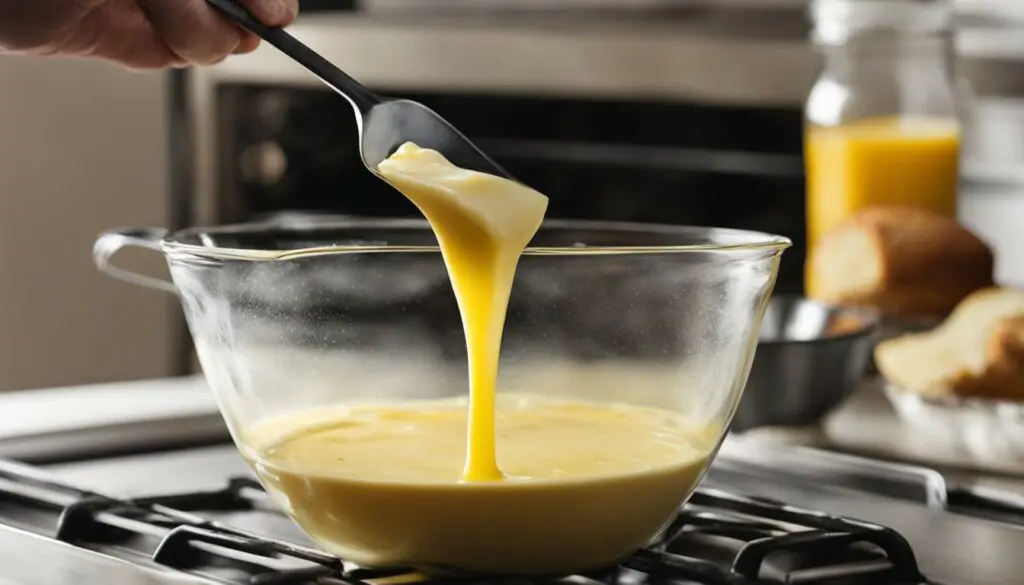
When using melted butter in baking, there are a few tips to keep in mind to ensure the best results. These tips will help you make the most of this versatile ingredient and create delicious baked goods.
1. Temperature and Consistency
First and foremost, make sure that the melted butter is at the right temperature and consistency for the recipe. It should be fully melted but not browned or overheated. This will ensure that it incorporates smoothly into the batter or dough and distributes evenly throughout.
2. Adjusting the Recipe
Since melted butter can affect the texture and density of baked goods, be prepared to adjust the recipe accordingly. For example, if you’re using melted butter instead of softened butter in a cookie recipe, you may need to reduce the amount slightly to prevent excessive spreading during baking. Similarly, you may need to chill the dough before baking to control the spread.
3. Texture and Density
Keep in mind that melted butter can result in a different texture and density compared to using softened butter. It can add moisture and richness to baked goods, resulting in a denser and chewier texture. Consider this when choosing recipes and aim for baked goods that align with your desired outcome.
By following these tips, you’ll be able to use melted butter effectively in your baking recipes. It offers a unique flavor and texture profile that can enhance a variety of baked goods. Just remember to adjust the recipe as needed and enjoy the delicious results!
Melted Butter for Buttercream and Frosting
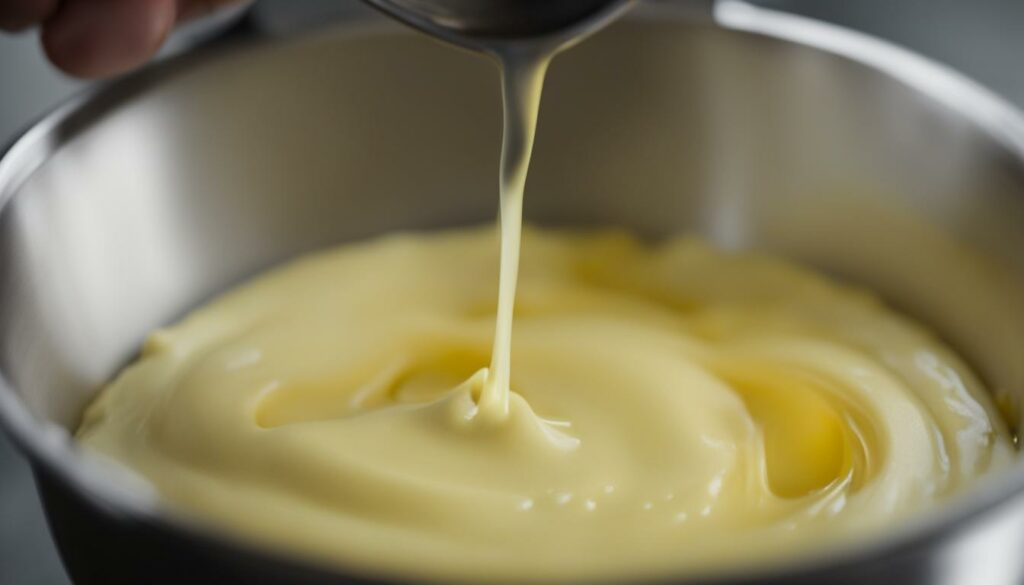
While melted butter can be a versatile ingredient in baking, it may not be suitable for all applications. In recipes like buttercream and frosting, where a specific texture and consistency are desired, softened butter is typically recommended. However, in cases where softened butter is not available, melted butter can be used as a substitute with caution. It may require adjustments to achieve the desired consistency.
| Pros of using melted butter in buttercream and frosting: | Cons of using melted butter in buttercream and frosting: |
|---|---|
|
|
When using melted butter in buttercream and frosting, it is important to keep in mind that the final result may differ from traditional recipes that call for softened butter. Melted butter may create a softer and more spreadable texture, which can impact the stability of the frosting. To compensate for the potential thinness, you can add additional powdered sugar or chill the frosting to firm it up.
Here is an example recipe for a simple buttercream using melted butter:
Ingredients:
- 1 cup melted butter
- 4 cups powdered sugar
- 1 teaspoon vanilla extract
- 2-3 tablespoons milk or cream (as needed for desired consistency)
Instructions:
- In a mixing bowl, combine the melted butter, powdered sugar, and vanilla extract.
- Gradually add milk or cream, one tablespoon at a time, until the desired consistency is reached. Mix until smooth and creamy.
- Use the buttercream to frost cakes, cupcakes, or other baked goods.
Baking Tips for Using Melted Butter
When it comes to baking with melted butter, there are a few essential tips that can help you achieve the best results. Whether you’re making cookies, cakes, or pie crusts, these tips will ensure that your baked goods turn out delicious and flavorful.
1. Read the Recipe Thoroughly:
Before you start baking, take the time to read the recipe thoroughly and understand the intended texture and outcome. Some recipes may specifically call for melted butter, while others may require softened butter. By understanding the recipe’s instructions, you can make the appropriate adjustments.
2. Incorporate Melted Butter Correctly:
When adding melted butter to your recipe, it’s crucial to incorporate it correctly. Make sure the melted butter is at the appropriate temperature before adding it to the other ingredients. Gradually incorporate the melted butter into the mixture while stirring continuously. This will ensure even distribution and prevent any clumps or separation.
3. Adjust Other Ingredients or Baking Techniques:
Using melted butter in a recipe may require adjustments to other ingredients or baking techniques. For example, if a recipe calls for creaming softened butter with sugar, you may need to adjust the amount of sugar or consider adding an extra leavening agent, such as baking powder, to compensate for the denser texture of melted butter. Additionally, chilling the dough before baking can help control spreading and achieve the desired shape.
4. Experiment and Adapt:
Experimentation is key when using melted butter in baking. Feel free to adapt recipes that call for softened butter and substitute it with melted butter to create a unique flavor and texture. Keep in mind that some recipes may require more trial and error to achieve the perfect balance of flavors and textures. Don’t be afraid to get creative and test different variations until you find the combination that suits your preferences.
By following these baking tips, you can confidently use melted butter in your baking recipes. Whether you’re looking to achieve a tender pie crust or a chewy cookie, melted butter can add a distinct flavor and texture to your baked goods. With proper understanding and technique, baking with melted butter can yield delicious and unique results.
Conclusion
The effects of melted butter on a recipe can be significant, altering the texture and outcome of the final product. While it may not produce the same results as using softened butter, melted butter offers a distinctive texture profile that some individuals may prefer. Understanding the effects of melted butter empowers bakers to make informed decisions when choosing the appropriate butter option for their recipes.
Experimentation and trial baking are encouraged to find the perfect balance of flavors and textures when incorporating melted butter in baking recipes. By adjusting other ingredients and techniques, bakers can achieve delicious and unique results. Whether opting for a moister and denser texture or a shorter and more tender crust, melted butter can add a delightful twist to traditional baking recipes.
While melted butter may not be suitable for all applications, it provides a convenient alternative in certain situations. By carefully considering the intended texture and consistency, bakers can decide whether to use melted butter or softened butter. It is important to note that melted butter may require adjustments to achieve the desired results, such as chilling the dough before baking to control spreading.
FAQ
Does using melted butter change a recipe that calls for softened butter?
Yes, using melted butter can have a significant impact on the texture and outcome of the final baked goods. Melted butter creates a different texture and can affect the rise and density of the recipe.
What are the advantages of using melted butter in baking?
Melted butter is quick and easy to prepare, making it a convenient option in recipes that require speed and simplicity. It can contribute to a moist and tender texture in baked goods.
What are the differences between melted butter and softened butter?
Softened butter is typically creamed with sugar to incorporate air into the dough, resulting in a lighter texture when baked. Melted butter, on the other hand, does not incorporate air and can lead to a denser, chewier texture.
How does melted butter affect pie crusts?
Using melted butter in pie crusts creates a more tender and shortbread-like texture compared to using cold butter, which creates flaky layers.
Melted butter can result in denser and lower-profile cookies and cakes. It adds moisture, richness, and a desirable chewiness to baked goods.
When should I use melted butter instead of softened butter?
Melted butter is best suited for drop doughs and cookie bars. It can be used as a substitute in recipes that call for softened butter, but adjustments and chilling the dough may be necessary to control spreading.
What are some techniques for melting butter?
Butter can be melted in the microwave in short bursts, stirring in between, or on the stovetop over low heat, stirring until completely melted. It is important to avoid browning or overheating the butter.
What are the pros and cons of softened butter versus melted butter?
Softened butter is typically used for a lighter texture, while melted butter can result in a denser and chewier texture. It is important to understand these effects when choosing the appropriate butter for a recipe.
What tips should I follow when using melted butter in baking?
Ensure the melted butter is at the right temperature and consistency for the recipe, be prepared to adjust the recipe and potentially chill the dough before baking, and understand the different texture and density that melted butter can bring to the final product.
Can I use melted butter for buttercream and frosting?
Softened butter is typically recommended for buttercream and frosting, as it provides the desired texture and consistency. Melted butter can be used as a substitute, but adjustments may be necessary to achieve the desired consistency.
What baking tips should I keep in mind when using melted butter?
Read the recipe thoroughly to understand the desired texture, ensure the melted butter is incorporated correctly, and be prepared to adjust other ingredients or baking techniques to accommodate the use of melted butter.
What is the conclusion regarding the effects of melted butter on a recipe?
Using melted butter in baking recipes can have a significant impact on the texture and outcome of the final product. It offers a different texture profile compared to using softened butter, and experimentations and trial baking are encouraged to find the perfect balance of flavors and textures.

